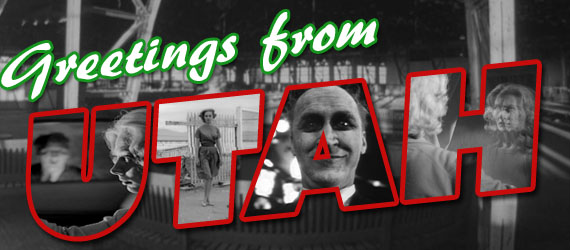
I’ve always wanted to travel across America. I’ve been a few times, to the major tourist attractions – Disneyworld in Florida, Vegas in Nevada, Cheers in Boston – but there’s so many places I’ve never seen in person, and most likely never will. Fortunately, there’s a solution, and it’s my own personal remedy to all life’s problems: movies. There’s been a movie set literally everywhere. Everywhere! So, this feature sees me cinematically visit a new state every week, through a film that was set there. You can read my journey so far here. Next up: Utah!
When an impromptu drag race ends in tragedy, Mary (Candace Hilligoss) leave home and heads to Utah, where she has been hired as a church organist. However, Mary’s journey and life soon becomes encumbered by the appearance of a creepy pale man, who seems to have something to do with the abandoned carnival just outside of town.
Before watching Carnival of Souls, literally all I knew about it was it was predominantly set in Utah, and was probably a horror film (hence why I saved it to review in October). I do enjoy going into a film this blind, especially because it happens so rarely these days, and here it paid off to some degree, because I had no clue as to what direction the film would be taking, but in the end I was let down by the predictable plotting, and how the overall mystery of the film is almost spelled out in the very title, meaning when some elements are left to be guessed at, no such guessing is required.
Essentially, Mary sees a mysterious pale figure everywhere she goes, and on occasion finds herself in situations where she is unable to be seen or heard by anyone around her, and in turn she cannot hear anything but herself. These scenes were a little unsettling, but provided more of a sense of unease than actually being frightening. It’s clear this film – which was made for approximately $33,000 back in 1962, making it one of the first low budget indie horrors – has influenced the works of John Carpenter and Wes Craven, to name just two, but the heavy effect it has had on subsequent horror films significantly lessens the impact of this film, because a lot of elements used here have been copied many times since. I know this is no fault of this film’s, but alas it is still the case.
The character of Mary leaves a little to be desired. She’s not exactly a nice person – often people are kind to her, and she doesn’t even respond with a courteous “please” or “thank you,” and she’s icy and stand-offish to those around her trying to help. However, it comes across well that this was not always the case, and is possibly a result of the accident at the start of the film. Very few other characters leave much of an impression, save Mary’s uncomfortably rapey fellow boarder Mr. Linden (Sidney Berger). The reason for this could be the fact that other than Mary, no-one else is really on screen long enough to make much of an impression.
The score is very organ-heavy, which fits, seeing as Mary is an organist, but I’ve never been a huge fan or organ music – I find it has too many heavy layers, all trying to out-do one another and generally resulting in a droning mess – so needless to say I wasn’t much of a fan of the film’s music. There’s a refreshing lack of special effects and gore, which makes the sense of dread and unease all the more impressive, given that it’s implied entirely through the performances, settings and that overpowering score. The closest we get to a visual effect is a mild rippling of the screen when Mary slips into a dream-like state, and the closest we get to a set-piece is Mary remaining in her car when it gets elevated in a garage. However, scenes like this aren’t played to their full potential, and some scenes that should lead to a shock play out exactly as anticipated, as in fact did the entire ending of the film.
Overall, whilst this is an important film in terms of its legacy, these days it plays out too predictably. There’s more than enough classic horror out there to catch up on instead.





